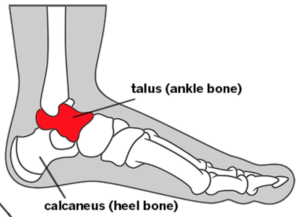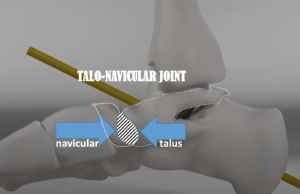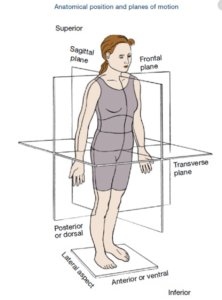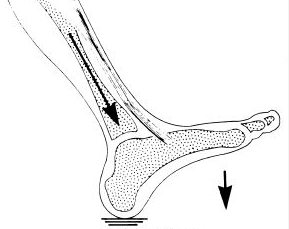The Third Ankle joint

ttps://www.hss.edu/condition-list_osteochondral-lesion-talus.asp
Understanding that there is a third ankle joint, let alone a second ankle joint, might seem bizarre. If you have been following my articles, the common denominator is the steering wheel or bone called the TALUS. This unique bone connects the foot to the leg bones. The ankle might appear as one joint, but because it only has one dimension of movement, it requires two other joints to provide a 3D movement known as the cardinal planes. So, to work effectively, the true ankle buddies up with other joints ‘many hands make light work’ sort of thing.
This is the last of my ankle joint series and takes us into more complex ideas based on why we have foot pain. In this article, I look at the talo-navicular joint, which will also relate to the height of the arch. What movement occurs here, and why is it so important?

Adapted from Dr Glass DPM to show the shaded head of the talus sitting in the deep navicular bone access Dec.2020 Link
The Talo-navicular joint
Looking at a diagram of this so-called third ankle joint makes more sense if illustrated in 3D. The following video highlights the movement around the talo-navicular joint (TNJ). Look at how the arch rises and falls as the foot rotates through the joint above the sub-talar joint (STJ). The yellow stick through this bone is useful because it shows the axis around which movement works.
The leg bones sit above the talus. Notice in the diagram how the leg rotates in one direction and causes the foot to turn in another direction. This twisting force is also called torque. The talus acts as a converter of leg rotation so that the foot has a smooth motion on ground contact. It is called a torque converter to give it a mechanical name. If the conversion between the joints did not arise, the knee would be damaged. The foot would also suffer great impact as it would fail to absorb the shock by slowing the collision.
Foot pain arises when joints fail to move in the right direction. Soft tissue is strained when asked to work harder. The contact surfaces of the ground, shoe, and foot lead to strain. If injury arises, symptoms lead us to seek help.
Expected movement of the ankle

Up and down movement is associated with the talo-crural joint or true ankle joint. This arises in the sagittal plane. The subtalar joint picks up the tilting inversion and eversion movement and predominantly moves in the frontal plane (illustrated). Too much movement leads to lateral ligament sprains. The reason we do not suffer medial ligament strain is because the talo-navicular joint is very stable. Like the hip and shoulder, it has a large ball surface that sits in a cup. The boat-shaped bone provides the cup called the navicular. The third movement is in the transverse plane and allows abduction and adduction. All these movements are illustrated beautifully in the video above.

https://www.acefitness.org/fitness-certifications/ace-answers/exam-preparation-Coutesy of blog/2863/the-planes-of-motion-explained/
The planes of motion can be examined using the link here, which expands on the illustration above. Each of the three joints contributes different movements so that the ankle works to establish normal function.
Compare the shared dominant movements in three planes
True ankle (Talo-crural joint or TCJ)
dorsiflexion +++ plantarflexion ++++ (sagittal plane movement)
Subtalar joint (STJ)
inversion ++++ eversion ++ (frontal plane movement) PLUS adduction +++ abduction +++ (transverse plane movement)
Talo-navicular joint (TNJ)
inversion ++ eversion + (frontal plane movement)
Why is the TNJ so important?
If the proper ankle and subtalar joint are the major joints, why do we need the TNJ? There are two reasons.
Firstly, the joint connects the front of the foot to the back of the foot. The significant forces associated with body weight pass through this joint, and the connecting joint has to be strong.
Secondly, it is a torque converter, which means that when we walk barefoot or in shoes, our feet can cope with both flat and uneven surfaces. The front of the foot adapts to the terrain, while the hind foot stays stable. If the TNJ is unstable, it flattens, causing what is so often described as a flat foot.
Although the TNJ does not appear to be part of the ankle, it truly is, and its importance has been recognised for over a century. Although it is a ball-and-socket joint, the remaining bones and associated foot joints ensure it does not move as freely as the hip or shoulder. Orthotic devices are often used to help unstable TNJs.
Author’s Note

The descriptions of the movement within the TNJ are more complex than described. The objective of this article has been to show a relative relationship between three joints that are essential to normal foot function around the hindfoot. Foot health professionals are required to study the intimate relationship of the foot and movement and should refer to the authoritative texts currently recommended. This article would be appropriate for lay readers and students in the early part of their careers. You can read about the other ankle joints on this site, starting with the ankle and walking. Footlocker also provides information on ankle sprains and self-help.
Thanks for reading ‘The Third Ankle Joint’ in my series about ankles and ankle sprains by David R Tollafield
Produced for ConsultingFootPain by Busypencilcase Reflective Communications Est. 2015
![]()
Stay in touch with new articles and go to the link – About

Recent Comments